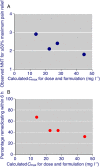Effects of food on pharmacokinetics of immediate release oral formulations of aspirin, dipyrone, paracetamol and NSAIDs - a systematic review
- PMID: 25784216
- PMCID: PMC4574824
- DOI: 10.1111/bcp.12628
Effects of food on pharmacokinetics of immediate release oral formulations of aspirin, dipyrone, paracetamol and NSAIDs - a systematic review
Abstract
Aims: It is common to advise that analgesics, and especially non-steroidal anti-inflammatory drugs (NSAIDs), be taken with food to reduce unwanted gastrointestinal adverse effects. The efficacy of single dose analgesics depends on producing high, early, plasma concentrations; food may interfere with this. This review sought evidence from single dose pharmacokinetic studies on the extent and timing of peak plasma concentrations of analgesic drugs in the fed and fasting states.
Methods: A systematic review of comparisons of oral analgesics in fed and fasting states published to October 2014 reporting kinetic parameters of bioavailability, time to maximum plasma concentration (tmax ), and its extent (Cmax ) was conducted. Delayed-release formulations were not included.
Results: Bioavailability was not different between fasted and fed states. Food typically delayed absorption for all drugs where the fasting tmax was less than 4 h. For the common analgesics (aspirin, diclofenac, ibuprofen, paracetamol) fed tmax was 1.30 to 2.80 times longer than fasted tmax . Cmax was typically reduced, with greater reduction seen with more rapid absorption (fed Cmax only 44-85% of the fasted Cmax for aspirin, diclofenac, ibuprofen and paracetamol).
Conclusion: There is evidence that high, early plasma concentrations produces better early pain relief, better overall pain relief, longer lasting pain relief and lower rates of remedication. Taking analgesics with food may make them less effective, resulting in greater population exposure. It may be time to rethink research priorities and advice to professionals, patients and the public.
Keywords: analgesic; bioavailability; food; maximum plasma concentration; oral; pharmacokinetic.
© 2015 The Authors. British Journal of Clinical Pharmacology published by John Wiley & Sons Ltd on behalf of The British Pharmacological Society.
Figures





Comment in
-
Reply to 'Effects of food on pharmacokinetics of immediate release oral formulations'.Br J Clin Pharmacol. 2015 Nov;80(5):1238. doi: 10.1111/bcp.12711. Epub 2015 Aug 27. Br J Clin Pharmacol. 2015. PMID: 26138369 Free PMC article. No abstract available.
-
Effects of food on pharmacokinetics of immediate release oral formulations.Br J Clin Pharmacol. 2015 Nov;80(5):1239. doi: 10.1111/bcp.12712. Epub 2015 Aug 27. Br J Clin Pharmacol. 2015. PMID: 26140311 Free PMC article. No abstract available.
-
Effects of food on pharmacokinetics of immediate release oral formulations of simple analgesics: potential implications for drug use, safety and efficacy.Br J Clin Pharmacol. 2015 Dec;80(6):1243-4. doi: 10.1111/bcp.12744. Epub 2015 Oct 26. Br J Clin Pharmacol. 2015. PMID: 26264792 Free PMC article. No abstract available.
References
-
- Clinical Knowledge Summary. Analgesia – mild to moderate pain. Available at http://cks.nice.org.uk/analgesia-mild-to-moderate-pain#!topicsummary (last accessed 1 December 2014)
-
- NHS Choices. Available at http://www.nhs.uk/Conditions/Anti-inflammatories-non-steroidal/Pages/Int... (last accessed 1 December 2014)
-
- Schubert I, Fessler J, editors. Hausärztliche Leitlinien: herausgeben von der Leitliniengruppe Hessen und der PMV forschungsgruppe. Deutscher: Ärzte-Verlag; 2009.
-
- Arthritis Medications: a consumer's guide. Available at http://www.arthritis.ca/document.doc?id=341 (last accessed 1 December 2014)
Publication types
MeSH terms
Substances
LinkOut - more resources
Full Text Sources
Other Literature Sources

